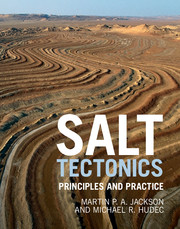Refine listing
Actions for selected content:
1211 results in Ebooks in petroleum sciences
Chapter 4 - Salt Pillows and Salt Anticlines
- from Part II - Salt Structures
-
- Book:
- Salt Tectonics
- Published online:
- 26 January 2017
- Print publication:
- 06 February 2017, pp 62-75
-
- Chapter
- Export citation
Chapter 15 - Influence of Salt on Petroleum Systems
- from Part IV - Practical Applications of Salt Tectonics
-
- Book:
- Salt Tectonics
- Published online:
- 26 January 2017
- Print publication:
- 06 February 2017, pp 424-456
-
- Chapter
- Export citation

Salt Tectonics
- Principles and Practice
-
- Published online:
- 26 January 2017
- Print publication:
- 06 February 2017

Risks, Rewards and Regulation of Unconventional Gas
- A Global Perspective
-
- Published online:
- 21 January 2017
- Print publication:
- 28 December 2016
Contents
-
- Book:
- Risks, Rewards and Regulation of Unconventional Gas
- Published online:
- 21 January 2017
- Print publication:
- 28 December 2016, pp v-vi
-
- Chapter
- Export citation
19 - Best Practice for Community Engagement: Determining Who is Affected and What is at Stake
-
-
- Book:
- Risks, Rewards and Regulation of Unconventional Gas
- Published online:
- 21 January 2017
- Print publication:
- 28 December 2016, pp 391-410
-
- Chapter
- Export citation
20 - Managing the Impact of Coal Seam Gas Water Extraction in the Surat Basin
-
-
- Book:
- Risks, Rewards and Regulation of Unconventional Gas
- Published online:
- 21 January 2017
- Print publication:
- 28 December 2016, pp 411-426
-
- Chapter
- Export citation
4 - Unconventional Hydrocarbons and the US Technology Revolution
-
-
- Book:
- Risks, Rewards and Regulation of Unconventional Gas
- Published online:
- 21 January 2017
- Print publication:
- 28 December 2016, pp 59-91
-
- Chapter
- Export citation
14 - Failure to Frack: Pitfalls of Governance and Risk in Polish Shale Gas
-
-
- Book:
- Risks, Rewards and Regulation of Unconventional Gas
- Published online:
- 21 January 2017
- Print publication:
- 28 December 2016, pp 267-285
-
- Chapter
- Export citation
1 - The Rise of Unconventional Gas: The Story So Far
-
-
- Book:
- Risks, Rewards and Regulation of Unconventional Gas
- Published online:
- 21 January 2017
- Print publication:
- 28 December 2016, pp 1-7
-
- Chapter
- Export citation
16 - Regulation of Unconventional Hydrocarbons in Alberta, Canada
-
-
- Book:
- Risks, Rewards and Regulation of Unconventional Gas
- Published online:
- 21 January 2017
- Print publication:
- 28 December 2016, pp 327-339
-
- Chapter
- Export citation
13 - Regulation of Unconventional Gas in India
-
-
- Book:
- Risks, Rewards and Regulation of Unconventional Gas
- Published online:
- 21 January 2017
- Print publication:
- 28 December 2016, pp 251-266
-
- Chapter
- Export citation
Foreword
-
- Book:
- Risks, Rewards and Regulation of Unconventional Gas
- Published online:
- 21 January 2017
- Print publication:
- 28 December 2016, pp xi-xii
-
- Chapter
- Export citation
Glossary and Acronyms
-
- Book:
- Risks, Rewards and Regulation of Unconventional Gas
- Published online:
- 21 January 2017
- Print publication:
- 28 December 2016, pp 486-488
-
- Chapter
- Export citation
Appendix: Units
-
- Book:
- Risks, Rewards and Regulation of Unconventional Gas
- Published online:
- 21 January 2017
- Print publication:
- 28 December 2016, pp 484-485
-
- Chapter
- Export citation
17 - When Unconventional Becomes Conventional: Regulation of Natural Gas Development in British Columbia, Canada
-
-
- Book:
- Risks, Rewards and Regulation of Unconventional Gas
- Published online:
- 21 January 2017
- Print publication:
- 28 December 2016, pp 340-373
-
- Chapter
- Export citation
5 - Risks and Opportunities of Unconventional Natural Gas: Australia and the United States
-
-
- Book:
- Risks, Rewards and Regulation of Unconventional Gas
- Published online:
- 21 January 2017
- Print publication:
- 28 December 2016, pp 92-110
-
- Chapter
- Export citation
9 - Unconventional Gas in the United Kingdom
-
-
- Book:
- Risks, Rewards and Regulation of Unconventional Gas
- Published online:
- 21 January 2017
- Print publication:
- 28 December 2016, pp 167-196
-
- Chapter
- Export citation
Preface
-
-
- Book:
- Risks, Rewards and Regulation of Unconventional Gas
- Published online:
- 21 January 2017
- Print publication:
- 28 December 2016, pp xiii-xvi
-
- Chapter
- Export citation
21 - Whole-of-Landscape Assessment and Planning in the Management of Unconventional Gas Exploration and Production in Australia
-
-
- Book:
- Risks, Rewards and Regulation of Unconventional Gas
- Published online:
- 21 January 2017
- Print publication:
- 28 December 2016, pp 427-450
-
- Chapter
- Export citation
